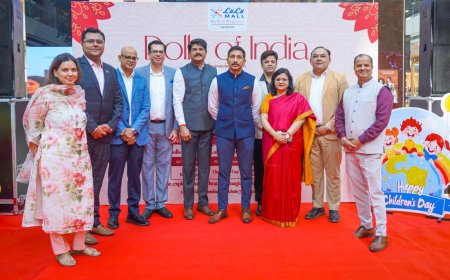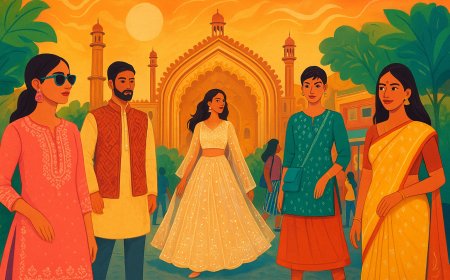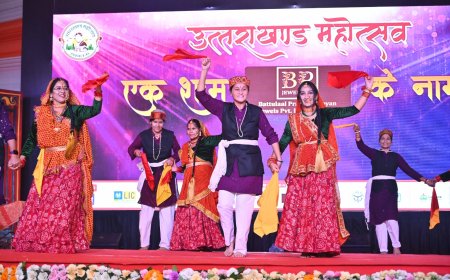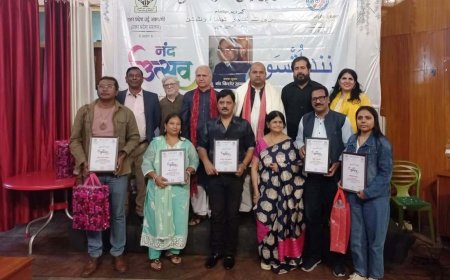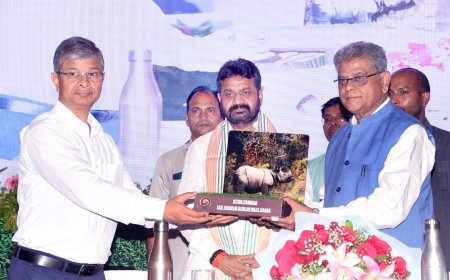Lucknow: A Timeless Symphony of Stone, Soul, and Splendor
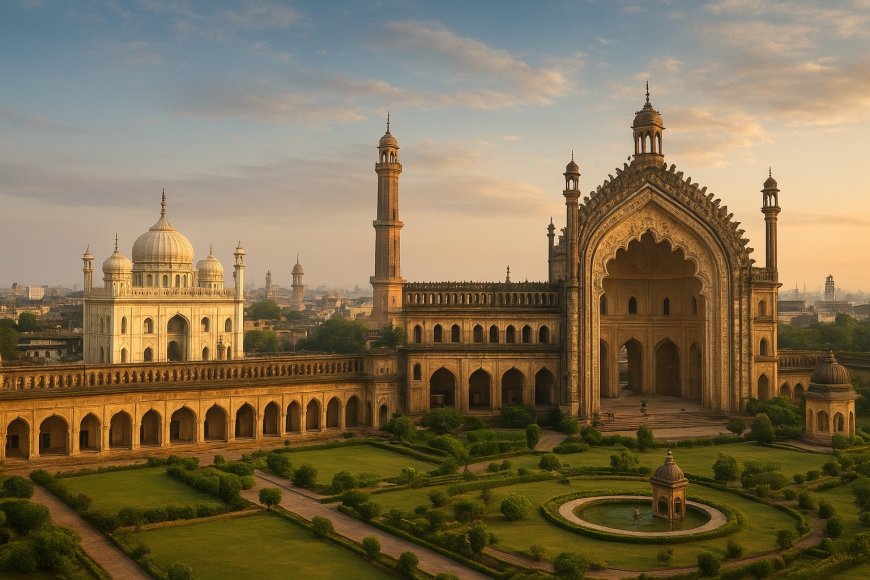
By Arijit Bose
Nestled gracefully on the banks of the Gomti River, Lucknow—capital of Uttar Pradesh—is not merely a city; it is an experience frozen in marble, lime, and memory. Dubbed the “City of Nawabs” and the “City of Tehzeeb,” Lucknow stands as a living museum of Indo-Islamic brilliance where the Nawabi grandeur of the 18th and 19th centuries still breathes through domes, arches, and courtyards. Here, Mughal majesty fuses seamlessly with Persian poetry, Hindu symbolism, and British precision—a blend that gives birth to the singular Awadhi architectural style.
The Birth of Awadhi Grandeur
When Nawab Asaf-ud-Daula shifted the Awadh capital from Faizabad to Lucknow in 1775, he envisioned a city that would rival Delhi’s imperial dignity while reflecting the distinct cultural ethos of Awadh. During a severe famine, he famously employed thousands in public construction, transforming hardship into heritage. The result was a unique architectural evolution—lavish, lyrical, and labyrinthine.
Unlike the austere symmetry of Mughal architecture in Delhi or Agra, Lucknow’s design embraced ornate stucco, mirror-worked interiors, and arched halls without wooden beams—a triumph of engineering and artistry. The Nawabs preferred embellishment over rigidity, beauty over monumentality. Every dome and lattice screen (jaali) bore stories of faith, festivity, and finesse.
Bara Imambara: The Heart of Nawabi Architecture
Among Lucknow’s architectural marvels, the Bara Imambara remains the crown jewel. Commissioned by Asaf-ud-Daula between 1784 and 1791, it was conceived as both a famine relief project and a sacred space for Shia mourning rituals during Muharram. Built entirely of interlocked bricks and lime mortar, its central hall—spanning nearly 50 meters—remains the world’s largest unsupported arched structure.
Adjacent lies the Bhool Bhulaiya, a bewildering labyrinth of 489 doorways and 1,000 corridors. Designed originally as a defensive maze, it now enthralls visitors who lose themselves amid its echoing passages before finding breathtaking views of the city’s skyline. The adjoining Shahi Baoli (royal stepwell) stands as a marvel of hydraulic ingenuity, reflecting both utility and mystique.
The Asfi Mosque within the complex, with its triple domes and delicate Persian detailing, amplifies the Imambara’s spiritual and aesthetic aura. In 2025, conservation work by the Archaeological Survey of India (ASI) has ensured that its acoustics and lime stucco remain intact, preserving the soundscape of centuries.
Rumi Darwaza: The Gateway of Grandeur
Standing sentinel to the Imambara is the Rumi Darwaza, Lucknow’s most iconic landmark. Rising nearly 60 feet, this majestic gateway was modeled after the Sublime Porte of Istanbul—symbolizing Lucknow’s cosmopolitan soul. Crafted from lakhauri bricks and red lime plaster, its intricate arches mirror chikankari embroidery patterns, fusing architecture with textile art.
Once serving as the ceremonial entrance to Old Lucknow, it now glows nightly under illumination, embodying the city’s resilience through sieges, storms, and centuries. The Darwaza doesn’t just open into streets—it opens into history itself.
Chota Imambara: The Palace of Lights
If the Bara Imambara is awe-inspiring, the Chota Imambara is intimate and radiant. Built in 1837 by Nawab Muhammad Ali Shah, it is a shrine of opulence. Silver-plated pulpits, Belgian chandeliers, and mirrored halls turn it into a “Palace of Lights,” especially during Muharram when thousands of lamps transform it into a celestial spectacle.
The Imambara houses the royal tombs and symbolizes a poignant final chapter of Nawabi splendor before British annexation in 1856. In recent years, the Uttar Pradesh Tourism Department’s restoration has returned its turquoise domes and Quranic calligraphy to their former brilliance.
British Imprints and the Echo of 1857
Lucknow’s story is incomplete without its colonial scars. The British Residency, built around 1800, stands as a solemn memorial to the Revolt of 1857. Once home to British officers, it became a battleground when Begum Hazrat Mahal and local forces laid siege for 87 days. The bullet-riddled walls and weathered Corinthian pillars now speak of defiance and tragedy.
Nearby lies Dilkusha Kothi, a hunting lodge modeled after England’s Seaton Delaval Hall. With its Baroque turrets and Ionic columns, it marks the fusion of Nawabi aesthetic with European design—a rare example of cultural dialogue amidst political discord.
Kaiserbagh: The Garden of Paradise
By the mid-19th century, Nawab Wajid Ali Shah envisioned Kaiserbagh Palace as his “Garden of Paradise.” Spread across 50 acres, it epitomized Indo-European grandeur. The marble Safed Baradari (White Pavilion) within the complex hosted royal durbars, mushairas (poetry recitals), and kathak performances, turning architecture into theatre.
Although much of Kaiserbagh was ravaged during the 1857 uprising, its surviving arches and courtyards still whisper of an era where architecture celebrated art, not authority.
Chattar Manzil: A Riverfront Gem
Another landmark along the Gomti, Chattar Manzil—the “Umbrella Palace”—combines Indo-Saracenic symmetry with French mansard roofs. Its golden dome, resembling an umbrella, became a symbol of royal grace. Recent flood-proofing and adaptive reuse in 2023 have transformed it into a heritage hub while retaining its majestic charm.
The City as a Living Museum
Old Lucknow’s streets themselves are architectural marvels. The narrow galis of Chowk and Aminabad, lined with ornate havelis, mirror the city’s social fabric. Balconies carved in floral patterns overlook bustling bazaars where gold-thread zardozi and chikan embroidery artisans still thrive.
Here, secular coexistence takes form in stone—Hindu motifs adorn mosque minbars, while Mughal domes rise beside temples. The Jama Masjid (1840) and Saadat Ali Khan’s tomb (1814) showcase a refined blend of Islamic and Hindu sensibilities, reflecting Lucknow’s famed Ganga-Jamuni tehzeeb—the spirit of unity in diversity.
Revival and Preservation in Modern Times
In 2025, Lucknow’s heritage is not confined to nostalgia; it is a living continuum. The Lucknow Development Authority has incorporated Awadhi motifs into modern structures, ensuring that the city’s skyline retains its cultural DNA. Initiatives under the Smart City Mission have connected heritage sites through eco-friendly corridors, integrating metro lines and pedestrian pathways.
Events like the Lucknow Mahotsav celebrate this spirit, combining light shows at Rumi Darwaza with classical performances at Safed Baradari. Digital innovation has brought heritage to fingertips—virtual tours of the Bhool Bhulaiya and AI-led architectural guides make exploration immersive for younger audiences.
However, challenges remain. Pollution threatens delicate stucco work, and encroachments endanger historic gardens. Conservation efforts—like laser scanning, lime-based restoration, and urban zoning—offer hope that heritage will not be sacrificed to modernization.
Lucknow’s Global Footprint
Beyond borders, Lucknow’s legacy resonates globally. In Toronto and Dubai, mosques inspired by Awadhi domes and arches echo its aesthetic. Hotels and public spaces across India draw from Nawabi elegance—testament to how architecture born of benevolence and beauty transcends time.
An Eternal Dialogue of Cultures
What sets Lucknow apart is not just its monuments but its message. Every structure here tells a human story—of compassion (Asaf-ud-Daula’s famine relief), devotion (Imambaras’ sanctity), defiance (Residency’s siege), and cultural coexistence (fusion of Hindu, Muslim, and European motifs).
In an increasingly homogenized world, Lucknow’s architecture stands as a reminder that hybridity is strength. Its domes and arches do not divide—they unite.
As poet Josh Malihabadi once said, “Lucknow is a city of gardens and ghazals.” Its monuments are verses etched in stone—melancholic yet majestic, ephemeral yet eternal. Standing at the confluence of past and present, Lucknow does not merely preserve history—it lives it, reminding us that elegance, empathy, and endurance can indeed coexist in every brick and every breath of the “City of Nawabs.”
What's Your Reaction?











